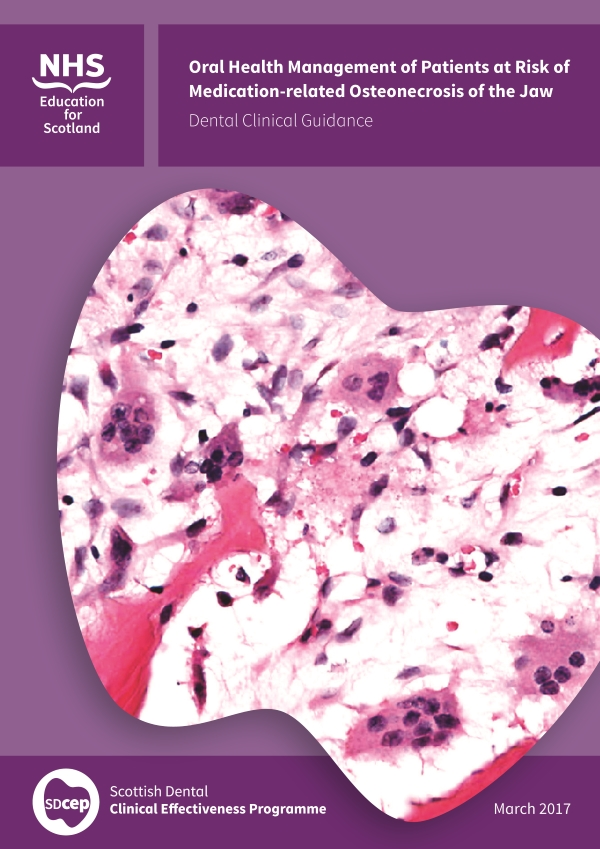
Oral Health Management of Patients at Risk of Medication-related Osteonecrosis of the Jaw
In March 2017, the Scottish Dental Clinical Effectiveness Programme (SDCEP) published guidance on the Oral Health Management of Patients at Risk of Medication-related Osteonecrosis of the Jaw. This is an update to the Oral Health Management of Patients Prescribed Bisphosphonates guidance, first published in 2011, and takes into account the wider range of drugs that have been implicated in the development of Medication-Related Osteonecrosis of the Jaw (MRONJ). Although the guidance is aimed primarily at dentists working in primary care dental practices, it is also of relevance to the secondary care dental services, those involved in dental education and undergraduate trainees, as well as to the prescribers and dispensers of these medications and to patients.
Consultation
To explore current practice and the barriers and facilitators to implementation of the guidance recommendations, as proposed in the guidance consultation draft, semi-structured interviews were carried out with dentists and pharmacists during SDCEP’s open consultation period. Thirteen dentists and 15 pharmacists participated, and the findings reported in the MRONJ diagnostic interviews summary (PDF). In addition, an online questionnaire survey was distributed to General Medical Practitioners (GMPs). Fifty-seven GMPs participated and the findings are reported in the MRONJ diagnostic GMP questionnaire summary (PDF).
Quality improvement (research)
To further inform the MRONJ diagnostic analyses and to support implementation of the guidance, a national Quality Improvement (QI) (Research) project was developed. QI (Research) projects are intended to support primary care dental practice teams explore and improve the quality of the care they deliver through participation in research. More information is available on the SDPBRN website.
The TRiaDS MRONJ QI (Research project) comprised four stages:
STAGE 1: Complete the pre‐publication questionnaire.
STAGE 2: On publication of the guidance, identify three recommendations included in the questionnaire where your practice could be improved, identify the main barriers and facilitators to compliance and develop and implement action plans for improvement.
STAGE 3: Complete the post‐publication questionnaire.
STAGE 4: Complete a reflective report, to includes reflections on each of the three recommendations identified in Stage 2, along with your overall reflections from participating in this project.
Five hundred randomly selected dentists were invited to complete the pre-publication questionnaire. Those that did so were eligible to take part in the QI (Research) project by undertaking Stages 2 – 4 of the QI (Research) project, if they wished to do so. Dentists who returned the pre-publication questionnaire were invited to complete the post-publication questionnaire six months following the publication of the MRONJ guidance.
Two hundred and eighteen dentists completed the pre-publication questionnaire. Of these 72 also completed the post-publication questionnaire with 56 certified by SDPBRN as having completed all four stages of the QI (Research) project. A summary of the results from the pre- and post-publication questionnaires are reported in the MRONJ dentist questionnaire summary (PDF).
National criterion-based audit
To support dentists measure and improve their compliance with the guidance recommendations a national criterion-based audit was developed in partnership with NHS Education for Scotland’s (NES) Dental Directorate CPD workstream. This audit was made available via the NES Portal in 2018 until the end of NHS Scotland’s Dental 2016-19 QI activity cycle. One hundred and thirty-eight dentists demonstrated improved compliance with the SDCEP MRONJ guidance recommendations and were certified by NES as having completed this audit.
